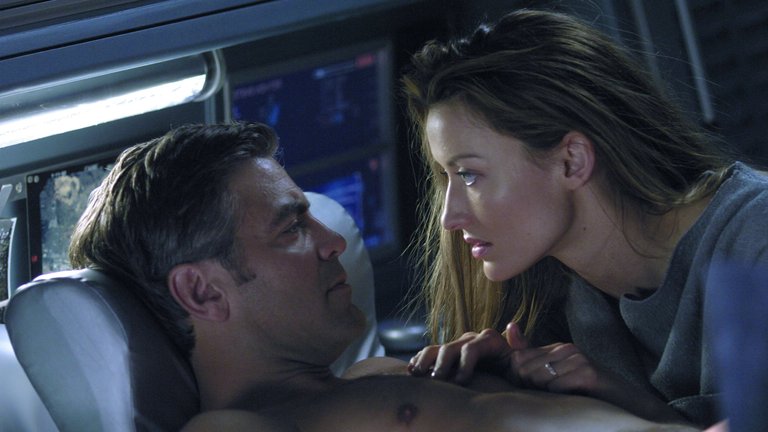Film Review: Solaris (2002)

Most Hollywood remakes are pointless, but there are some films that beg to be remade. A good case can be made for Solaris, the 1972 Soviet science fiction film that is considered something of a classic of the genre and arguably the most popular work in the career of celebrated Russian director Andrei Tarkovsky. However, even some of its admirers tend to recognise that it would struggle to gain fans among regular filmgoers today due to its excessive length, Tarkovsky's reputation as an arthouse filmmaker, and the financial and technological limitations that made the film appear aged and inferior to Western science fiction films even fifty years ago. So, what would happen if Hollywood decided to remake this film with a bigger budget, better special effects, a big star in the lead role, a producer with science fiction classics in his credits, and a talented director known for diverse themes and experimentation with different styles? The answer was provided in 2002 with Solaris, a film produced by James Cameron and directed by Steven Soderbergh.
The film represents the third adaptation of the eponymous 1961 novel by Polish author Stanislaw Lem (the first was a 1968 Soviet television play). The plot is set in an unspecified but relatively near future, sometime in the mid to late 21st century, after the discovery of a large planet called Solaris. The protagonist is Chris Kelvin (played by George Clooney), a psychologist who is sent to Prometheus, a research station orbiting Solaris. He is called by his friend Dr. Gibarian (played by Ulrich Tulkur), one of the scientists among the station’s crew, in a message before contact was apparently lost. Upon arrival, Kelvin learns that Gibarian has committed suicide, while two surviving scientists – Dr. Snow (played by Jeremy Davies) and Dr. Gordon (played by Viola Davis) – are paranoid and acting strangely. Kelvin soon discovers that this might be related to the frightening phenomena he experiences himself – the appearance of a woman who looks and talks exactly like Rheya (played by Natascha McElhone), his wife who committed suicide years earlier. Shocked at first, Kelvin reacts by tricking her into an escape pod and launching it into space. But another Rheya returns, and his crewmates explain that each of them experiences such “visitors” that are apparently created by the planet below out of their memories or past traumas. Kelvin is, however, happy that he has another chance to live with his long-lost wife, although Rheya gradually realises that she isn’t the real person.
Enjoyment of Soderbergh’s Solaris depends significantly on whether someone has watched Tarkovsky’s version. Those who have not are likely to appreciate Soderbergh’s work more than those who have. On the other hand, it would be unfair to say that the new version doesn’t have at least some improvements over the old. The most obvious is the much better pacing, with Soderbergh abandoning Tarkovsky’s long shots, resulting in his film being almost twice as short. The special effects also look much better, although the new Solaris depicts the space station as a cold and unattractive place, much like the old one. Although Soderbergh’s script strays from both Lem’s original novel and the 1972 script, there are too many similarities that make the new film appear to be a little too faithful and, more importantly, too Hollywood-like retelling of the old story. The main problem is the casting of George Clooney, who was a top star at the time but seems strangely disinterested in his role, and his star presence only makes his performance much inferior to that of Donatas Banionis, who played the same character in the 1972 film. The same can be said for Natascha McElhone, a talented actress who doesn’t possess the same beauty and seductive quality as Natalya Bondarchuk in the Soviet version, and whose lack of chemistry with Clooney makes the film quite disappointing. The worst miscasting is that of Jeremy Davies, whose mannerisms make his character annoying, while Viola Davis barely appears in the film. The biggest flaw of Solaris, however, is one shared with Tarkovsky’s version – too much emphasis on the doomed romance between the protagonist and his wife’s ghost at the expense of the “science” aspects of science fiction. High expectations based on the notable names behind the project didn’t help, and the 2002 version of Solaris received mostly mixed reviews, ultimately failing at the box office, despite Clooney devotees receiving fan service in the form of the actor briefly showing his naked posterior. Soderbergh continued to make interesting films, but this attempt to build on the classics of the science fiction genre ended up as one of the less memorable pieces of his filmography.
RATING: 4/10 (+)
_
Blog in Croatian https://draxblog.com
Blog in English https://draxreview.wordpress.com/
InLeo blog https://inleo.io/@drax.leo
InLeo: https://inleo.io/signup?referral=drax.leo
Unstoppable Domains: https://unstoppabledomains.com/?ref=3fc23fc42c1b417
Hiveonboard: https://hiveonboard.com?ref=drax y
Bitcoin Lightning HIVE donations: https://v4v.app/v1/lnurlp/qrcode/drax
Rising Star game: https://www.risingstargame.com?referrer=drax
1Inch: https://1inch.exchange/#/r/0x83823d8CCB74F828148258BB4457642124b1328e
BTC donations: 1EWxiMiP6iiG9rger3NuUSd6HByaxQWafG
ETH donations: 0xB305F144323b99e6f8b1d66f5D7DE78B498C32A7
Posted using CineTV